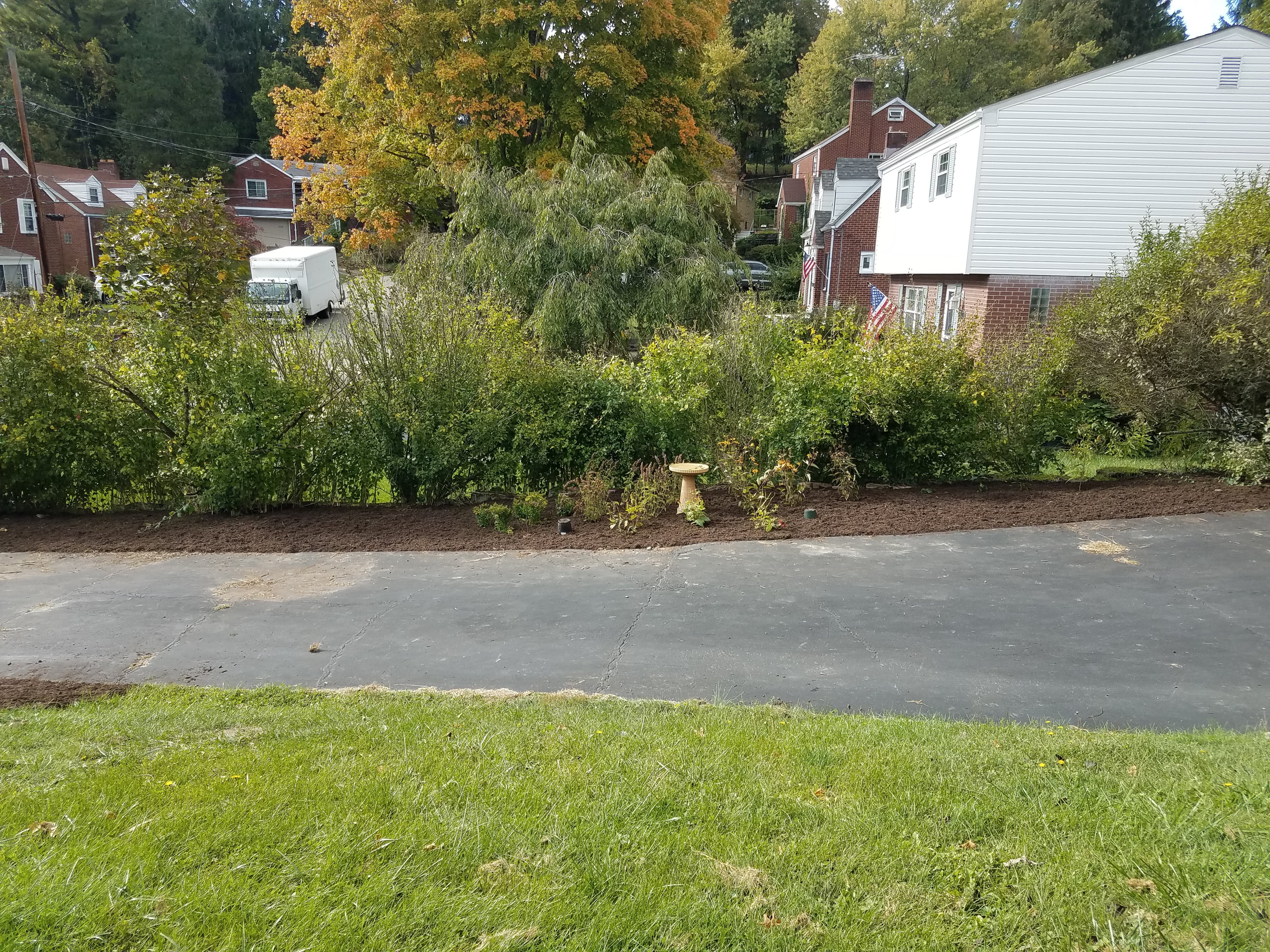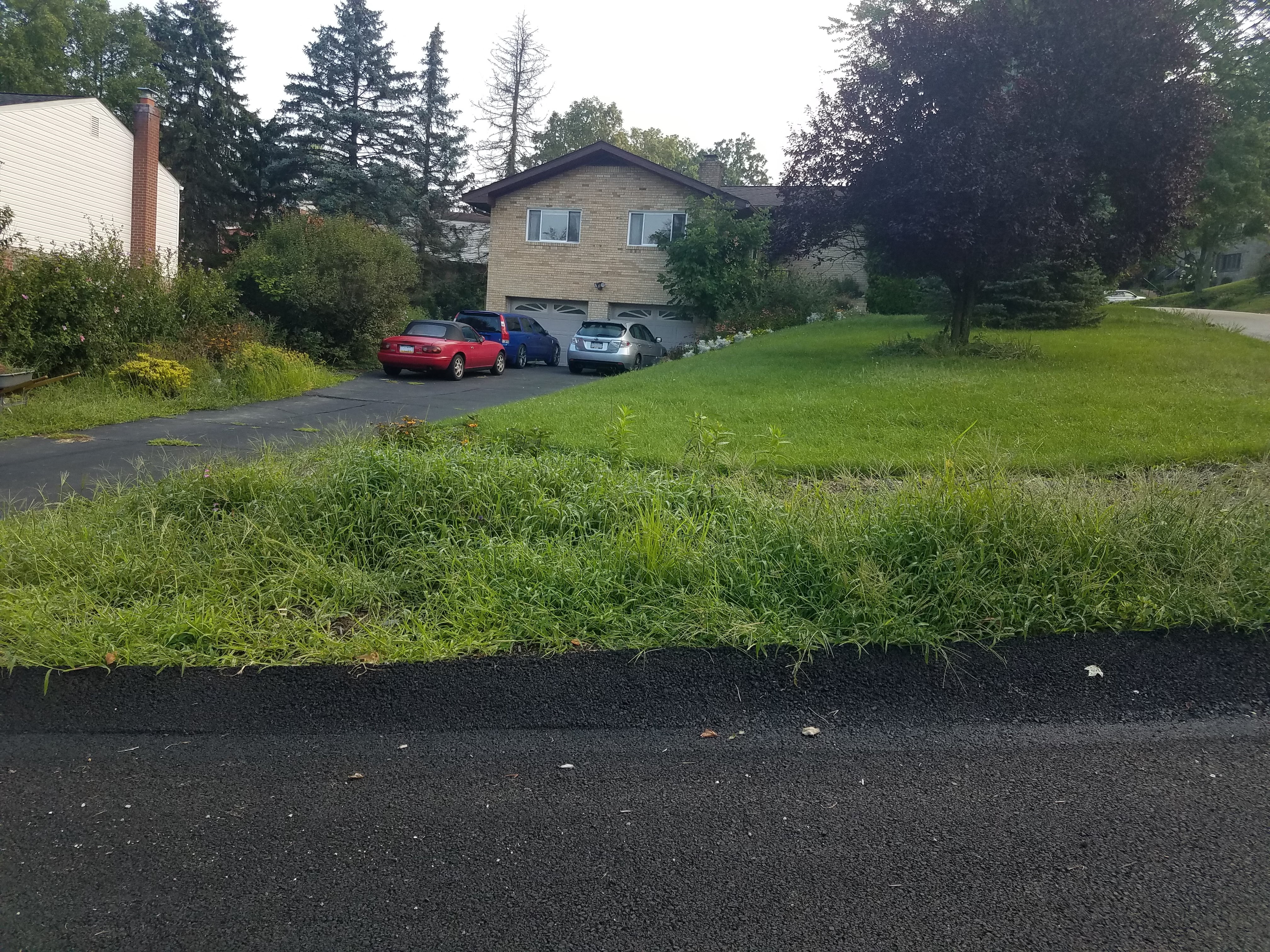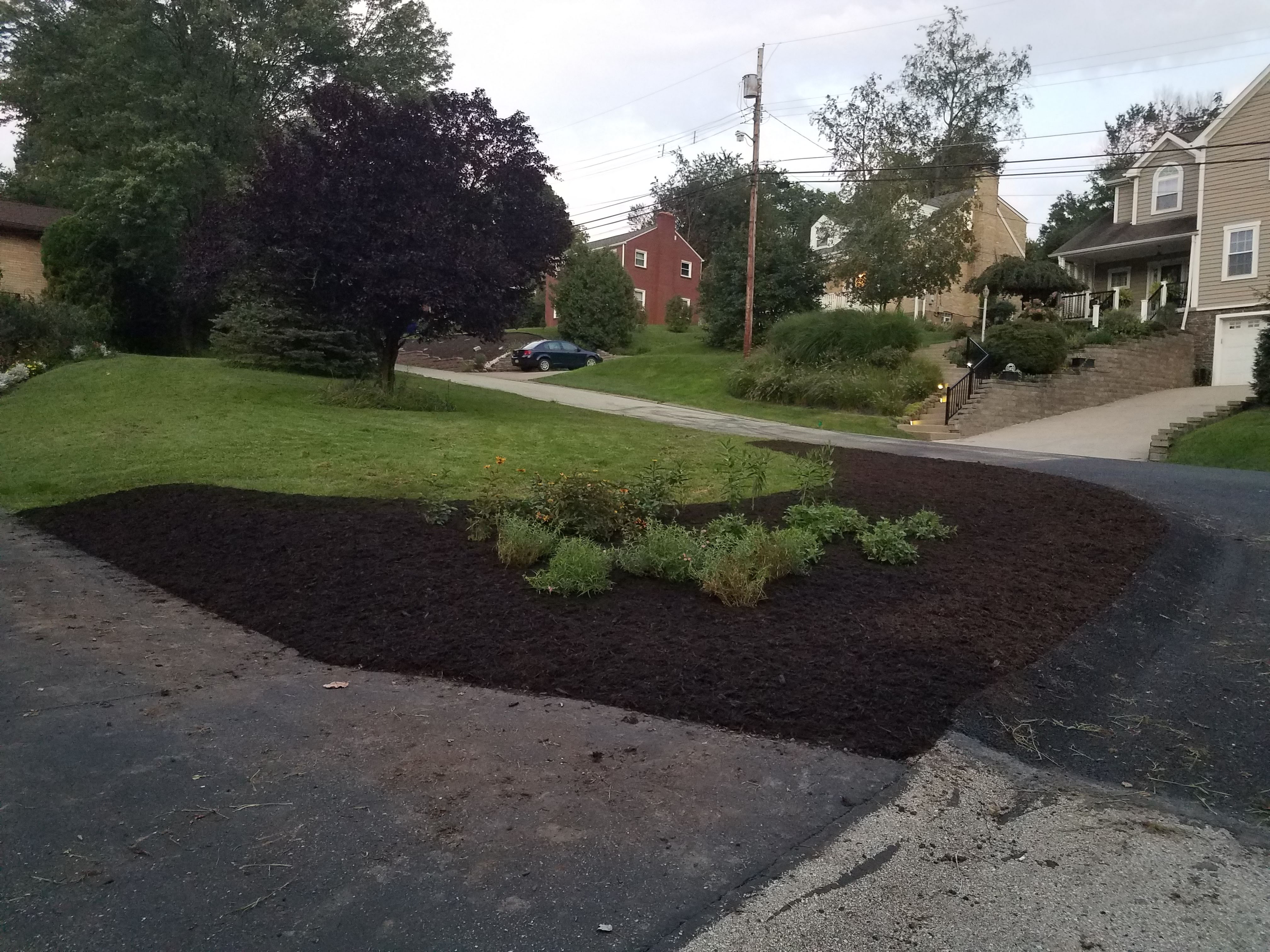Two years ago I started to convert about 1000 square feet of lawn into pollinator-friendly garden space: one long, thin strip along our driveway (which is a pain to mow) and the corner of our property (which looked incredibly boring with nothing but grass). I clearly overestimated my available time and energy in what should have been a multi-year endeavor, as I have spent massive quantities of both since then doing battle with the grass and weeds that had squatter’s rights.
The grass has been more tenacious in these two new spaces than it was in front of my house, where I previously added about 250 square feet in front of the pathetic little brick planter that skirts our front porch. It took about three years to get most of the worst weeds under control there: at first large grasses, then buttercups the next year, and mats of clover the year after that. This year I’ve gotten some smaller, more isolated eruptions of spurge, dandelions, and some clover, but five years in, it’s getting very manageable (especially as the soil gets more conditioned from annual mulching).
I started these two new beds by laying down cardboard and mulch, rather than ripping up sod or tilling the ground, as we did with the first garden. Also, while I got to planting right away in the first garden, I’ve only planted a fraction of the new beds so far, first because there’s so much space to cover, and second because I have hit analysis paralysis with what to plant. I’m guessing that without new plants spreading their roots throughout the soil, the original grasses don’t have much competition and therefore have a better chance of fighting back. (Choosing not to till the soil probably also made a difference.)

Out with the Weeds
I knew going in that it would be a multi-year process, and my next door neighbor regularly chides me for not spraying weed killer or spreading plastic over the area I’m trying to convert. That’s a hard no to both: I won’t spray chemicals such as glyphosate because of the harm it could do to the pollinators I’m trying to feed, and I won’t put down plastic to kill grass and weeds because I’m trying to protect the microbes in the soil, not burn them with excessive heat or starve them of oxygen.
My price for those decisions has been constant vigilance and constant weeding. Unfortunately, after long trips out of town both last summer and this summer, I returned home to grass going to seed in these new garden beds. This year we even got a nasty-gram from our borough about the state of the grass – in the garden, not on the lawn. In all fairness, it had grown so high that you could not even see the few plants that had made it into the ground earlier in the season.
Starting last fall, I began spreading corn gluten meal on my garden beds. I’ve written about it previously as a pre-emergent weed killer.[1] It is natural, and it dries out emerging shoots to prevent sprouting seeds from taking root. For established plants, it acts as a fertilizer as it breaks down. What that means is that if you don’t time it correctly or get the right wet-dry cycles as seeds are sprouting, you could just be fertilizing your weeds.

My plan is to keep spreading corn gluten meal on a regular basis in spring and fall to stop the seeds and then just pull existing weeds as they appear. It is supposed to be effective at preventing about 60% of seeds from establishing in the first year, with 100% weed control in as early as five years. I fear my timeline may have been extended because I let grass go to seed in the same places two years in a row, but I will say that they were far easier and faster to pull this year than last year (probably not 60% easier, but still noticeably so.)
In with the Plants
I’ve been taking my time trying to plan out the new gardens perfectly: artistically landscaped with all the right plants to bloom at different times and support different pollinators. My aunt (who holds degrees in both art and horticulture) would be perfect for this task and has done incredible work in her clients’ yards. However, she’s always very busy running her garden center, so I feel bad asking for help.
She stocks out-of-the ordinary plants that I can’t find elsewhere, and she makes great recommendations on what the bees will love, so I generally come back to Pittsburgh with a carful of wonderful things for the garden. As to where I should put them, she just encourages me to trust my own judgment, try things out, and move the plants around later if they don’t look good where they are. I suppose since I’m going for a look that’s somewhere between a cottage garden and a meadow, that’s not the worst advice, but it’s hard when I want it to look perfect right away.
Since starting these new beds, I’ve been trying to prioritize native, pollinator-friendly species, but that takes a lot of time, research, and frustration if you can’t find what you’re looking for. Native plants will be more likely to support native pollinators, which is the best argument for choosing them. More selfishly, another thing I like about native plants is that they’re good for the lazy (or busy!) gardener: once you’ve found what you want, they require the least amount of work because they’ve evolved to live where you do, and they all look good together no matter what.

The catch, however, is finding them. Many of the beautiful pollinator plants carried by garden centers are non-native, which isn’t necessarily a bad thing, but they can be more likely to require special care (e.g. extra water) or take over a garden bed. For example, the plumbago I put in to line part of the front garden is native to western China and, although not considered invasive, has been referred to as “aggressive.”[2] I need to keep an eye on it and cut it back regularly, as it is starting to crowd out the other plants around it. (I might transplant some to areas of my yard where I’ve had trouble getting things to grow.)
Over the past year, I’ve been back east to see my family three times. Each time, I’ve returned with as many plants as will fit in the car and still leave room for my cat, who regularly rides shotgun. Given enough time, I’m sure my gardens will be full of birthday and Christmas presents. I’m not complaining at all, but coming home with new plants did force my hand on starting the garden. The plants didn’t have the time to wait for me to come up with my grand design – they needed to go in the ground. Getting started is the hardest part of any new project for me, but my aunt is right: I can always change my mind later.
Welcome, Visitors!
Perennials that have made it into the new gardens so far include almost exclusively native species. (The meadow sage was an impulse purchase). So far we have these beauties:
- “Burning Hearts” False Sunflower (Heliopsis) – eastern and central North America [3]
- Bee Balm (Monarda) – eastern North America [4]
- “Blue Boa” Agastache (Anise hyssop) – North America [5]
- “Red Rocks” Beardtongue (Penstemon) – North America [6]
- Dwarf Goldenrod (Solidago) – mid-Atlantic states [7]
- Meadow Sage (Salvia nemorosa) – Europe, Asia [8]

But wait! There’s more:
Part of my grand plan was to have as much milkweed as possible in order to feed and attract monarch butterflies.[9] About three years ago I ordered some seeds, but it was too late in the season to plant them by the time I thought of it. Then when it was time to plant them the next spring, I learned that they needed to think they went through a winter (meaning a few months in the fridge or freezer). Once again I missed a planting deadline. Finally, this spring, I got some seeds in peat pots early in the spring. It took 1-2 months for them to get started, depending on the species… and there they sat until I got around to planting them halfway through the summer.
Some took root and grew like crazy, while others have taken their time to get going. I was thrilled to see one tiny monarch caterpillar on one of them in August, but remnants of Hurricane Ida came through a few days later, battering everything in the garden, and I didn’t see him again. I hope that all of the milkweed will come back bigger and stronger next year and hopefully host a few new baby monarchs.
Despite all of the almost constant work I’ve put into the gardens since March, it has been incredibly rewarding to see different visitors come through to explore the flowers. We’ve had quite a few tiger swallowtails and monarchs, honeybees and bumblebees, moths and flies of every size, and several hummingbird moths, which I discovered a few years ago and love to see annually on my butterfly bushes and phlox. And although it broke my heart to take down the hummingbird feeder earlier this year,[10] the hummingbirds continued to stop by and help themselves to my salvia, monarda, and cardinal creeper vine all summer.
~
Have you done any pollinator-friendly and/or native-species gardens? I’d love to hear what you planted and who is enjoying it.
Thanks for reading!
[1] https://radicalmoderate.online/eco-friendly-weed-control-2020-update/
[2] https://piedmontmastergardeners.org/article/plumbago-a-true-blue-accent-in-the-sunny-border/
[3] https://www.gardenia.net/plant/heliopsis-helianthoides-var-scabra-burning-hearts
[4] https://www.gardenia.net/plant/monarda-jacob-cline-beebalm
[5] https://www.gardenia.net/plant/agastache-blue-boa
[6] https://www.highcountrygardens.com/perennial-plants/penstemon/penstemon-mexicali-red-rocks
[7] https://www.highcountrygardens.com/perennial-plants/solidago/solidago-sphacelata-golden-fleece
[8] https://www.gardenia.net/plant/salvia-nemorosa-ostfriesland-sage
[9] https://radicalmoderate.online/monarch-101/
[10] https://radicalmoderate.online/novel-bird-disease/
0 Comments